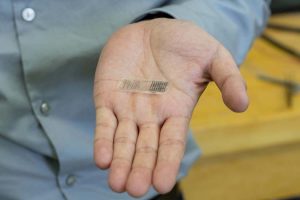
Self-powered implantable device stimulates faster bone healing
Canadian Plastics
Materials Research & DevelopmentWhen placed over a fracture, the device generates electricity from movement, accelerating bone healing, and then disappears without a trace.

UW-Madison professor Xudong Wang holds a fracture electro-stimulation device he and his lab designed. When placed over a fracture, the device generates electricity from movement, accelerating bone healing. Photo Credit: University of Wisconsin-Madison College of Engineering
Four years ago, Green Bay Packers quarterback Aaron Rodgers broke his right collarbone in a game against the Minnesota Vikings. Typically, it takes about 12 weeks for a collarbone to fully heal, but fans and commentators were hoping the three-time MVP might recover early and save a losing season.
One such hopeful was Xudong Wang, a professor of materials science and engineering at the University of Wisconsin-Madison (UW-Madison) and an expert in creating thin, movement-powered medical devices. As described by Jason Daley in a UW-Madison College of Engineering news article, researchers know that electricity can help speed up bone healing due to the fact that bone is a piezoelectric material, meaning it produces a tiny bit of electricity when placed under strain; these jolts of electricity stimulate factors that promote bone growth and healing, which is why electro-stimulation is an effective therapy. But “zapping” fractures with electricity has never really caught on, since it requires surgically implanting and removing electrodes powered by an external source.
A major update of that same electro-stimulation concept, Wang’s latest invention didn’t come in time to help the 2017 Packers, alas, but it may help many others by making electro-stimulation a much more convenient option to speed up bone healing.
As described in Daley’s article, the thin, flexible device is self-powered, implantable and bioresorbable, which means that once the bone is knitted back together, the device’s components dissolve within the body. Putting the device inside the body, however, has unique requirements, Wang said, including the problem of powering it. “The ideal case is to have the device be self-generating, which was something that didn’t exist before this,” he said.
To create the new fracture electro-stimulation device (FED), Wang and his team started with a triboelectric nanogenerator, a thin-film device with microstructured surfaces that converts mechanical energy produced by tiny movements into electric power. They coupled the nanogenerator with a pair of electrodes to distribute the electric field to the bone. They built these ultrathin, biodegradable and bioresorbable components on a substrate of PLGA, or poly(lactic-co-glycolic acid), a commonly used FDA-approved biocompatible polymer.
The researchers’ initial tests confirmed that small movements of the device did indeed create an electrical stimulation of about four volts, which it could sustain for over six weeks. They then tested the device on rats.
Those implanted with the device completely recovered from a tibia fracture in about six weeks, much more quickly than animals in a control group. The mineral density and flexural strength of the healed bones also reached the same level as healthy bones in the animals that received the electro-stimulation. After the treatment, the devices degraded and absorbed into the rats’ bodies with no complications and no need for surgical removal.
And according to Wang, it’s possible to fine-tune how long the stimulator will last within the body – anywhere from weeks to months – by tweaking the properties of the bioresorbable material coating the device.
Eventually, Daley wrote, Wang would like to scale up the FED so that it will work in humans. But for these self-powered devices, the energy source can be a factor, since the person wearing a cast might not produce enough mechanical energy to power the nanogenerator. “The way a rat moves provides constant stimulation for the device, but for a broken bone in a human that can’t be moved, that’s an issue,” Wang said. One solution comes from the human body itself: a body provides virtually endless sources of movement that could power the FED if the broken bone must remain immobile. “We may need the device to respond to other types of internal mechanical sources, like blood pressure changes,” said Wang, who’s already looking to the FED’s future. “It will be very interesting and impactful to address the development from animal to human.”
